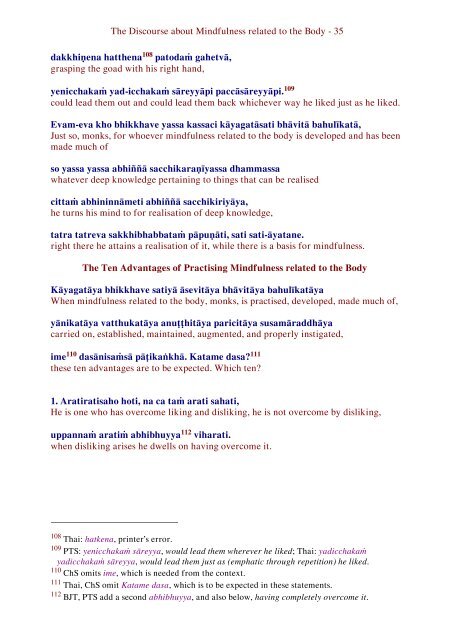Kayagatasatisuttam, the Discourse about Mindfulness related to the Body
A Pāli and English line by line (interlinear) version of this important discourse about the development of various meditations related to the body (together with extensive annotation).
A Pāli and English line by line (interlinear) version of this important discourse about the development of various meditations related to the body (together with extensive annotation).
You also want an ePaper? Increase the reach of your titles
YUMPU automatically turns print PDFs into web optimized ePapers that Google loves.
The <strong>Discourse</strong> <strong>about</strong> <strong>Mindfulness</strong> <strong>related</strong> <strong>to</strong> <strong>the</strong> <strong>Body</strong> - 35<br />
dakkhiṇena hat<strong>the</strong>na 108 pa<strong>to</strong>daṁ gahetvā,<br />
grasping <strong>the</strong> goad with his right hand,<br />
yenicchakaṁ yad-icchakaṁ sāreyyāpi paccāsāreyyāpi. 109<br />
could lead <strong>the</strong>m out and could lead <strong>the</strong>m back whichever way he liked just as he liked.<br />
Evam-eva kho bhikkhave yassa kassaci kāyagatāsati bhāvitā bahulīkatā,<br />
Just so, monks, for whoever mindfulness <strong>related</strong> <strong>to</strong> <strong>the</strong> body is developed and has been<br />
made much of<br />
so yassa yassa abhiññā sacchikaraṇīyassa dhammassa<br />
whatever deep knowledge pertaining <strong>to</strong> things that can be realised<br />
cittaṁ abhininnāmeti abhiññā sacchikiriyāya,<br />
he turns his mind <strong>to</strong> for realisation of deep knowledge,<br />
tatra tatreva sakkhibhabbataṁ pāpuṇāti, sati sati-āyatane.<br />
right <strong>the</strong>re he attains a realisation of it, while <strong>the</strong>re is a basis for mindfulness.<br />
The Ten Advantages of Practising <strong>Mindfulness</strong> <strong>related</strong> <strong>to</strong> <strong>the</strong> <strong>Body</strong><br />
Kāyagatāya bhikkhave satiyā āsevitāya bhāvitāya bahulīkatāya<br />
When mindfulness <strong>related</strong> <strong>to</strong> <strong>the</strong> body, monks, is practised, developed, made much of,<br />
yānikatāya vatthukatāya anuṭṭhitāya paricitāya susamāraddhāya<br />
carried on, established, maintained, augmented, and properly instigated,<br />
ime 110 dasānisaṁsā pāṭikaṅkhā. Katame dasa? 111<br />
<strong>the</strong>se ten advantages are <strong>to</strong> be expected. Which ten?<br />
1. Aratiratisaho hoti, na ca taṁ arati sahati,<br />
He is one who has overcome liking and disliking, he is not overcome by disliking,<br />
uppannaṁ aratiṁ abhibhuyya 112 viharati.<br />
when disliking arises he dwells on having overcome it.<br />
108 Thai: hatkena, printer’s error.<br />
109 PTS: yenicchakaṁ sāreyya, would lead <strong>the</strong>m wherever he liked; Thai: yadicchakaṁ<br />
yadicchakaṁ sāreyya, would lead <strong>the</strong>m just as (emphatic through repetition) he liked.<br />
110 ChS omits ime, which is needed from <strong>the</strong> context.<br />
111 Thai, ChS omit Katame dasa, which is <strong>to</strong> be expected in <strong>the</strong>se statements.<br />
112 BJT, PTS add a second abhibhuyya, and also below, having completely overcome it.

















